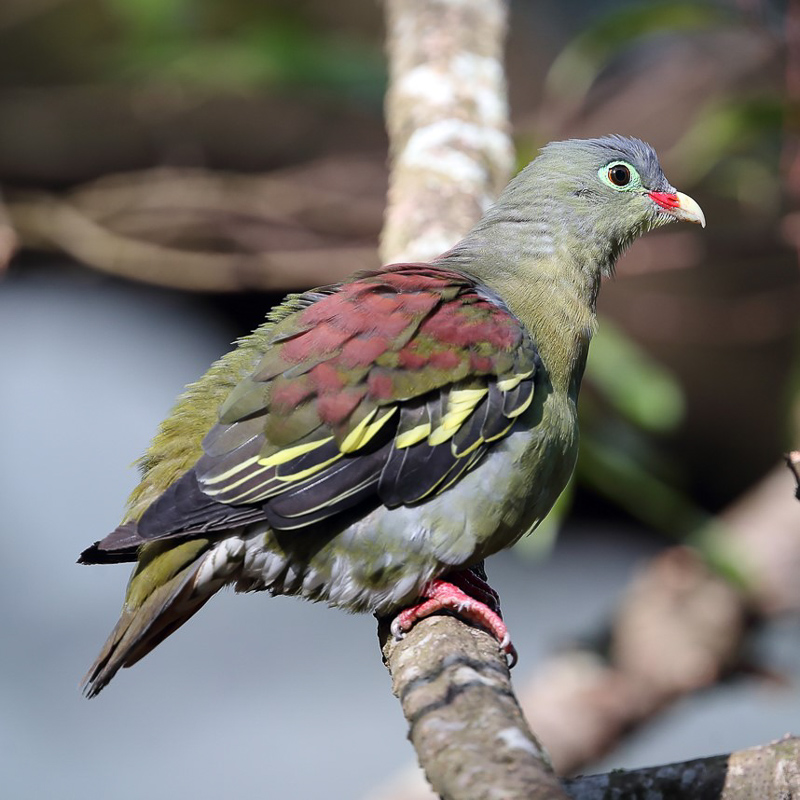Thick-billed Green Pigeon Treron curvirostra 厚嘴綠鳩
Category I. Rare winter visitor and passage migrant.
IDENTIFICATION

Jan. 2022, Michelle and Peter Wong. First-winter male.
24-31 cm. Separated from other similar species in the genus by its red-based thick pale bill and broad greenish-blue orbital ring. The scapulars are maroon on males. The greyish tone to the face, nape and flanks and the lack of solid maroon in the scapulars on the bird illustrated indicates it is in its first winter.

Dec. 2018, Michelle and Peter Wong.
The mantle and scapulars are green on females.
VOCALISATIONS
Not recorded vocalising in HK.
DISTRIBUTION & HABITAT PREFERENCE
Recorded in the central New Territories, on HK and Lantau Islands, and on Po Toi, mostly in fruiting Ficus trees in fung shui woods or closed-canopy shrubland, and on two occasions on the top of bare trees on the urban fringe.
OCCURRENCE
There are ten records dating back to 1986, all in the period from 8 November to 26 February except for one on 11 April.
1986: a juvenile male found freshly dead at KFBG on 8 November (Viney 1987, Melville 1990).
1993: a female at Yung Shue O on 4 December.
1996: a female found freshly dead at KFBG on 15 January.
2004: a female at Ha Fa Tsuen from 28 November to 2 December.
2006: a female in the Lam Tsuen Valley from 5 to 27 January.
2018: a female on Po Toi from 6 to 20 December.
2019: one at Ap Lei Chau on 2 February, one at Tung Chung on 26 February, a male at Shek Kong Catchwater on 11 April and a male near Tsing Tam Reservoir, Tai Lam CP on 11 December.
BEHAVIOUR, FORAGING & DIET
Secretive, typically remaining in canopy without moving for long periods, but also occasionally seen perched in the open on a bare branch. Individuals have been noted feeding in fruiting Ficus trees at several sites, the only species identified being Ficus virens at Ha Fa Tsuen.
Melville (1990) stated that the bird in 1986 had suspended/arrested moult and was therefore a juvenile given that pigeons and doves undergo a complete post-juvenile moult and the retained feather was only moderately worn.
RANGE & SYSTEMATICS
Widely distributed from central Nepal and northeast India through Burma and Indochina to southwest China and Hainan, and south to the Malaysian Peninsular, Sumatra, Borneo and the Philippines (Baptista et al. 1997). In China, T. c. nipalensis is resident in south and southwest Yunnan and Guangxi, while T. c. hainanus is endemic to Hainan, and there are occasional records unassigned to subspecies from southwest Guangxi and Matsu Island (off the coast of Fujian) (Liu and Chen 2020).
CONSERVATION STATUS
IUCN: Least Concern. Population trend decreasing.
Baptista, L. F., P. W. Trail and H. M. Horblit (1997). Family Columbidae (Pigeons and Doves). Pp. 60-243 in: del Hoyo, J., Elliot, A. and J. Sargatal. Handbook of the Birds of the World, vol. 4: Sandgrouse to Cuckoos. Lynx Edicions, Barcelona, Spain.
Liu, Y. and Y. H. Chen (eds) (2020). The CNG Field Guide to the Birds of China (in Chinese). Hunan Science and Technology Publication House, Changsha.
Melville, D. S. (1990). Thick-billed Pigeon in Hong Kong: notes on moult. Hong Kong Bird Report 1989: 150-151.
Viney, C. (1987). Specimen record of Thick-billed Pigeon Treron curvirostra from the Territory of Hong Kong. Hong Kong Bird Report 1986: 76-79.

